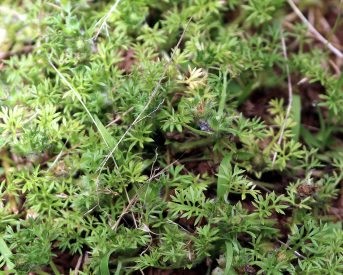By Mallory KelleyRegional Extension AgentHome Grounds, Gardens, Home Pests
Your thoughts of those pesky stickers in your turfgrass this summer may be a distant memory now, but if you don’t want to battle them again next early summer, now is the time to act!
Lawn burweed (Soliva sessilis) is a winter annual that germinates throughout thin turf in the fall months as temperatures cool. It is small and not very noticeable during the cold winter months. However, as
temperatures warm in the early spring, lawn burweed initiates a period of rapid growth and begins to form spine-tipped burs at the base of each leaf. The seed is contained within the hooked bur.
Now that you know what it is, the most important question remains – how can you get rid of it? The best strategy in controlling lawn burweed is to apply a preemergence herbicide, containing the active ingredients atrazine or isoxaben in early October, before the winter weeds germinate. This method will kill it upon sprouting and greatly reduce its presence in your yard next spring. One point to mention – these products are available in either a granular or liquid form. Granular products require ½ inch of rainfall or irrigation to become active.
Just in case you have a few weeds that escape the preemergence herbicide (which is not unusual), you can also spot spray with a postemergence herbicide. The key to success is to treat between November and February, when lawn burweed is very small and much easier to control. During this time, the weed has yet to develop the spine-tipped burs. Spray your lawn with a postemergence herbicide containing the active ingredients of three broadleaf weed killers: 2,4-D, dicamba, and mecoprop (MCPP). Many brands of broadleaf herbicides on the shelf contain these ingredients. Using the herbicide 2-4-D alone may not be quite as effective, so a three-in-one product is preferred. Keep in mind that broadleaf herbicides are not effective unless applied when the air temperature is above 68 °F. The window of opportunity can be very limited during the winter season. Again, another reason to use pre-emergence herbicides in the fall.
Unfortunately, most people do not notice a lawn burweed problem until warmer temperatures arrive. However, waiting until spring is too late. If you delay until April or May to attempt lawn burweed control, you are fighting a losing battle. Once the weed has reached a more mature state, multiple herbicide applications may be necessary, which can increase the potential for turfgrass injury. Because lawn burweed is a winter annual, it will begin to succumb to the warmer air temperatures (~90 °F); however, the spines have already formed and will remain after the weed withers and dies. Mowing the area at a very low height and bagging the seeds might offer some relief.
Some severe situations may call for killing the entire area, including the turfgrass, with a non-selective herbicide, such as glyphosate. Of course, one will have to replant grass or lay new sod but this method may be worth it, since it will ensure no more lawn burweed!
Dead or alive, lawn burweed poses a painful problem. The only solution is early identification and control. Remember lawn burweed is an annual and will come back from seeds that develop each spring. Take action now for prickle-free turf later.
 Part of the Alabama Cooperative Extension Service (ACES)
Part of the Alabama Cooperative Extension Service (ACES)
